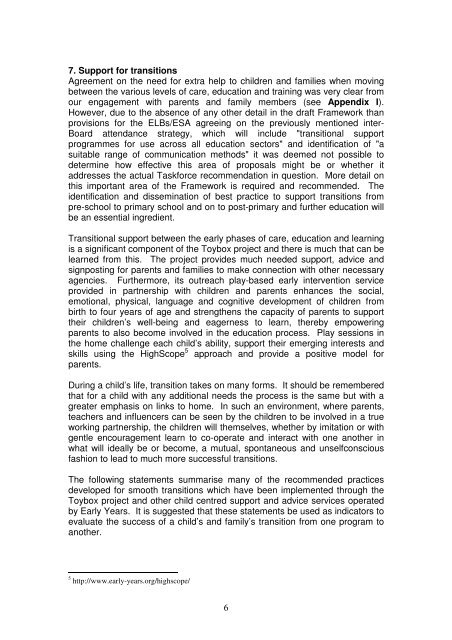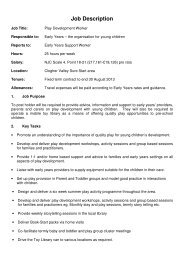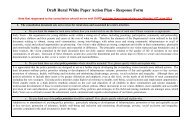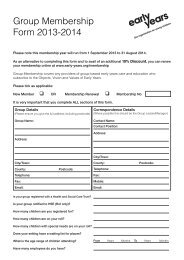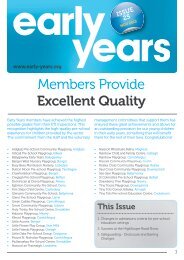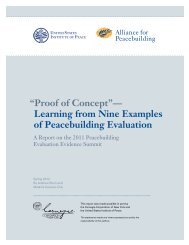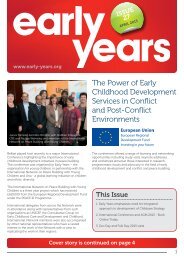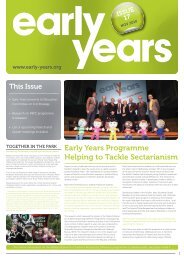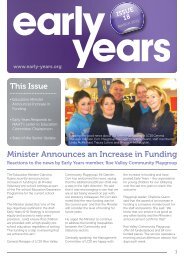Traveller Child in Education Action Framework - Early Years
Traveller Child in Education Action Framework - Early Years
Traveller Child in Education Action Framework - Early Years
You also want an ePaper? Increase the reach of your titles
YUMPU automatically turns print PDFs into web optimized ePapers that Google loves.
7. Support for transitionsAgreement on the need for extra help to children and families when mov<strong>in</strong>gbetween the various levels of care, education and tra<strong>in</strong><strong>in</strong>g was very clear fromour engagement with parents and family members (see Appendix I).However, due to the absence of any other detail <strong>in</strong> the draft <strong>Framework</strong> thanprovisions for the ELBs/ESA agree<strong>in</strong>g on the previously mentioned <strong>in</strong>ter-Board attendance strategy, which will <strong>in</strong>clude "transitional supportprogrammes for use across all education sectors" and identification of "asuitable range of communication methods" it was deemed not possible todeterm<strong>in</strong>e how effective this area of proposals might be or whether itaddresses the actual Taskforce recommendation <strong>in</strong> question. More detail onthis important area of the <strong>Framework</strong> is required and recommended. Theidentification and dissem<strong>in</strong>ation of best practice to support transitions frompre-school to primary school and on to post-primary and further education willbe an essential <strong>in</strong>gredient.Transitional support between the early phases of care, education and learn<strong>in</strong>gis a significant component of the Toybox project and there is much that can belearned from this. The project provides much needed support, advice andsignpost<strong>in</strong>g for parents and families to make connection with other necessaryagencies. Furthermore, its outreach play-based early <strong>in</strong>tervention serviceprovided <strong>in</strong> partnership with children and parents enhances the social,emotional, physical, language and cognitive development of children frombirth to four years of age and strengthens the capacity of parents to supporttheir children’s well-be<strong>in</strong>g and eagerness to learn, thereby empower<strong>in</strong>gparents to also become <strong>in</strong>volved <strong>in</strong> the education process. Play sessions <strong>in</strong>the home challenge each child’s ability, support their emerg<strong>in</strong>g <strong>in</strong>terests andskills us<strong>in</strong>g the HighScope 5 approach and provide a positive model forparents.Dur<strong>in</strong>g a child’s life, transition takes on many forms. It should be rememberedthat for a child with any additional needs the process is the same but with agreater emphasis on l<strong>in</strong>ks to home. In such an environment, where parents,teachers and <strong>in</strong>fluencers can be seen by the children to be <strong>in</strong>volved <strong>in</strong> a truework<strong>in</strong>g partnership, the children will themselves, whether by imitation or withgentle encouragement learn to co-operate and <strong>in</strong>teract with one another <strong>in</strong>what will ideally be or become, a mutual, spontaneous and unselfconsciousfashion to lead to much more successful transitions.The follow<strong>in</strong>g statements summarise many of the recommended practicesdeveloped for smooth transitions which have been implemented through theToybox project and other child centred support and advice services operatedby <strong>Early</strong> <strong>Years</strong>. It is suggested that these statements be used as <strong>in</strong>dicators toevaluate the success of a child’s and family’s transition from one program toanother.5 http://www.early-years.org/highscope/6


